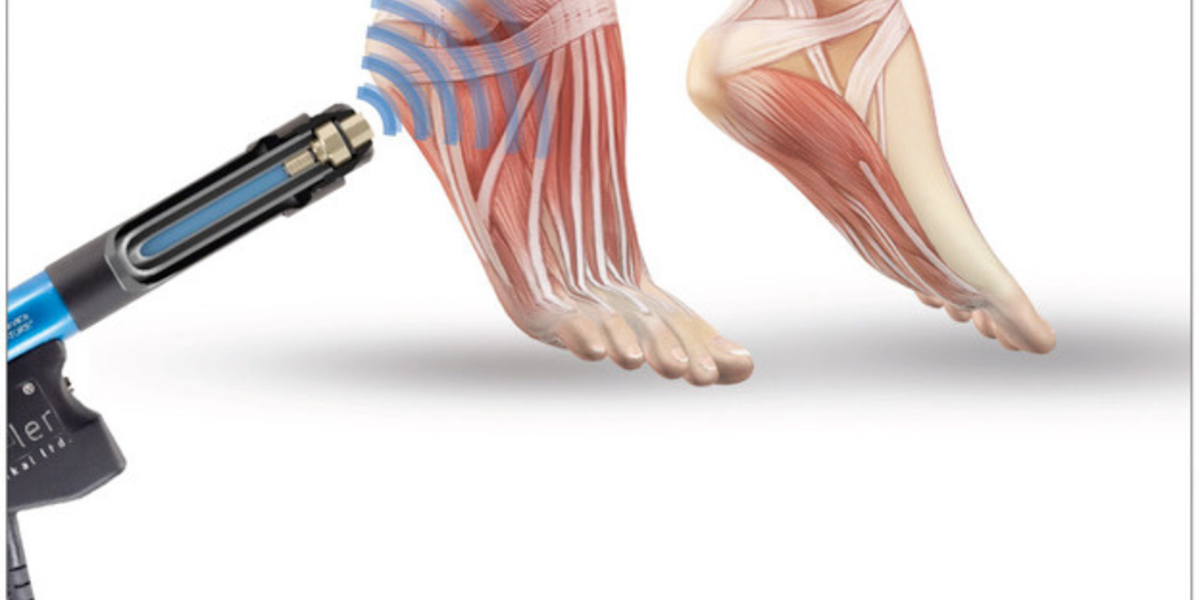Find out more about how this website uses cookies to enhance your browsing experience.
Healing Plantar Fasciitis with Modus Radial Shockwave Therapy: A Comprehensive Guide

Plantar fasciitis is a common yet debilitating condition that affects millions of people worldwide. Characterised by stabbing pain in the heel, especially in the morning or after long periods of standing, it can have a significant impace on quality of life. While traditional treatments like rest, ice, and physical therapy have been the mainstays, interventions such as Modus Radial Shockwave Therapy (RSWT) are gaining traction for their effectiveness and non-invasive nature. In this blog, we'll explore what Modus Radial Shockwave Therapy is, how it works, and why it's becoming a go-to treatment for plantar fasciitis.
Understanding Plantar Fasciitis
Before diving into the specifics of RSWT, it's important to understand the condition we are aiming to treat. The plantar fascia is a thick band of tissue that runs across the bottom of the foot, connecting the heel bone to the toes. It’s job is to support the arch of the foot and absorb shock when walking. Plantar fasciitis occurs when this tissue becomes inflamed or irritated, often due to excessive strain or repetitive motion.
Common risk factors include:
Obesity
Prolonged standing
High-impact activities
Improper footwear
Age (more common in middle-aged adults)
Traditional treatments for plantar fasciitis focus on reducing inflammation and pain.
These include:
Rest and Ice: To reduce inflammation and pain.
Physical Therapy: Stretching and strengthening exercises.
Orthotics: Custom-made shoe inserts to support the arch.
Medications: Nonsteroidal anti-inflammatory drugs (NSAIDs).
Injections: Corticosteroids to reduce severe inflammation.
Surgery: In extreme cases, surgical intervention may be necessary.
While these treatments can be effective, they often require a prolonged recovery period and may not always address the root cause of the problem.

What is Modus Radial Shockwave Therapy?
Modus Radial Shockwave Therapy is a non-invasive treatment that uses high-energy shockwaves to stimulate healing in damaged tissues. Originally developed to break up kidney stones, RSWT has found applications in various musculoskeletal disorders, including plantar fasciitis.
The therapy involves the following steps:
Application of Gel: A gel is applied to the affected area to ensure efficient transmission of shockwaves.
Shockwave Generation: A handheld device generates radial shockwaves, which are then directed to the painful area.
Treatment Sessions: Each session typically lasts anywhere from 4 to 20 minutes, with most patients requiring 3-6 sessions over several weeks.
How Does Modus Radial Shockwave Therapy Work?
RSWT works by inducing microtrauma in the affected tissue, which triggers the body's natural healing response.
Here's a closer look at the mechanisms involved:
Increased Blood Flow: Shockwaves enhance blood circulation in the treated area, promoting nutrient and oxygen delivery essential for healing.
Cellular Repair: The microtrauma caused by shockwaves stimulates the production of collagen, a vital component in tissue repair.
Pain Reduction: Shockwaves disrupt pain receptor activity, providing immediate pain relief.
Breaking Down Calcifications: In cases where calcified deposits are present, shockwaves help break them down, reducing pain and inflammation.
Benefits of Modus Radial Shockwave Therapy
The growing popularity of RSWT for plantar fasciitis is due to its numerous benefits:
Non-Invasive: No surgery or injections are required.
Quick Recovery: Patients can return to their regular activities almost immediately.
Minimal Side Effects: Unlike medications and injections, RSWT has few side effects, primarily limited to temporary discomfort or redness in the treated area.
High Success Rate: Many patients experience significant pain reduction and improved function after just a few sessions.
Real-World Results
Clinical studies and patient testimonials highlight the effectiveness of RSWT. A study published in the Journal of Orthopaedic Research found that RSWT significantly reduced pain and improved function in patients with chronic plantar fasciitis. Similarly, numerous patients have reported marked improvements in their symptoms, often describing RSWT as a life-changing treatment.
Conclusion
Plantar fasciitis can be a challenging condition to manage, but advancements in medical technology like Modus Radial Shockwave Therapy offer new hope. By leveraging the body's natural healing processes, RSWT provides a non-invasive, effective solution for those struggling with this painful condition. If you or someone you know is suffering from plantar fasciitis, consider discussing Modus Radial Shockwave Therapy with a healthcare provider to see if it's the right option for you.
References
Rompe JD, et al. (2002). Shockwave therapy for chronic plantar fasciitis. Journal of Orthopaedic Research.
Gerdesmeyer L, et al. (2008). Radial extracorporeal shock wave therapy is safe and effective in the treatment of chronic recalcitrant plantar fasciitis. American Journal of Sports Medicine. Patient testimonials and case studies on the effectiveness of RSWT.